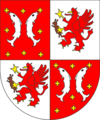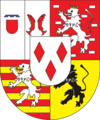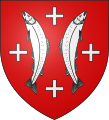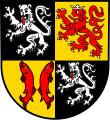Salm (noble family)
|
Territory in the Holy Roman Empire |
|
|---|---|
| Niedersalm | |
| coat of arms | |
 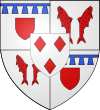
|
|
| map | |
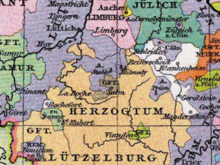
|
|
| Niedersalm (brown) and surrounding territories around 1400 | |
| Alternative names | Alt-Salm, Salm-Reifferscheid |
| Ruler / government |
Count from 1790: Prince |
| Today's region / s | BE-WLX , exclaves in DE-NW |
| Parliament | Imperial Council : 2 Kuriatsstimme on the westf. Count bank for Salm and Dyck |
| Reichskreis | Lower Rhine-Westphalian |
| Capitals / residences | Vielsalm , Reifferscheid , Dyck |
| Dynasties | Salm 1416/55: Reifferscheid
|
| Incorporated into | 1794: France 1815: Prussia
|
|
Territory in the Holy Roman Empire |
|
|---|---|
| (Ober-) Salm | |
| coat of arms | |
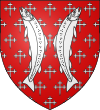
|
|
| map | |
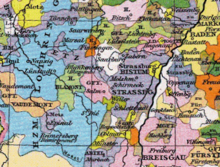
|
|
| Obersalm (pink) and surrounding territories around 1400
|
|
| Ruler / government |
Count from 1623: Prince |
| Today's region / s | FR-67 |
| Parliament |
Reichsfürstenrat : from 1654 : 1 viril vote on the secular bank for Anholt : 1 curiate vote on the westf. Count Bank |
| Reichskreis | Upper Rhine |
| Capitals / residences | Salm Castle Salm -Salm : Badonviller , Senones , Bocholt / Anholt Salm-Kyrburg : Kirn |
| Dynasties | Salm House 1475: Wild and Rhine Counts
|
| Incorporated into | 1600: parts of Lorraine Salm-Salm : 1793 to France , Salm-Kyrburg : 1794 to France , 1815 to Prussia , Condominium Salm-Salm and Salm-Kyrburg in the Principality of Salm (1802–1811), 1811 annexation by France , 1815 to Prussia
|
Salm is the name of an originally Moselle count family , a branch of the Wigeriche , named after the Vielsalm castle in the Ardennes (today Belgium ) and the newly founded Salm castle in the Vosges Mountains in Alsace (today France ) at the end of the 12th century .
As early as the Middle Ages, the sex was divided into the two main lines of Oberalm and Lower Alm, both of which later became extinct in the male line and bequeathed their possessions to other noble families, who then also called themselves Counts of Salm . These families were again divided into sub-lines, which were later elevated to the rank of prince, some of which still exist today and belong to the high nobility .
history
Origin ("Wigeriche" to Lorraine and Luxembourg)
The progenitor was Wigerich , Count Palatine of Lorraine († before 919). His presumed son Siegfried († 998) is at the top of the list of the Counts of Luxembourg . His grandson Giselbert († 1056/59) carried the title of Count of Salm in 1036 and that of Count of Luxembourg in 1047. He divided the property between his sons Konrad I of Luxembourg and Hermann von Salm († 1088), the latter not only being the progenitor of the Salm family , but also the anti-king of Henry IV .
Division into Oberalm and Niedersalm
Hermann's grandson Heinrich I in turn divided the county again in 1163: his son Heinrich II got the areas in the Vosges (the so-called Grafschaft Obersalm ), the daughter Elisabeth or the son-in-law Count Friedrich II von Vianden the areas in the Ardennes ( from then on Niedersalm ). From this point on there were two counties Salm with different lines of development in the empire.
Niedersalm line (1163–1794)
Niedersalm of the Vianden tribe (from 1163)
Friedrich II. Von Vianden and Elisabeth von Salm founded the Niedersalm line (the tribe of the Counts of Vianden ). The Counts of Salm in the Ardennes descend from them and die out with Count Heinrich VII of Niedersalm († 1416).
Niedersalm of the Reifferscheidt tribe (from 1416)
Count Heinrich VII von Niedersalm († 1416) bequeathed the possession of the Niedersalm line to his nephew Johann V. von Reifferscheid († 1418) after his children had all died before him . The gentlemen von Reifferscheidt and Dyck were probably his closest blood relatives. They can be traced for the first time at the end of the 12th century and originally owned a small lordship in the Eifel in the area around Reifferscheid and Wildenburg . Johann VI. von Reifferscheid († 1475), the son of Johann V, was finally awarded the possession of the Niedersalm line in 1456 by a judgment of the Council of the Duchy of Luxembourg. From 1460 Johann VI called himself. also Count of Salm . He is the progenitor of the Salm-Reifferscheidt lines that were later elevated to the prince :
- Salm-Reifferscheidt-Bedburg (called themselves Salm-Reifferscheidt-Krautheim from 1804 , Salm-Reifferscheidt-Krautheim and Dyck from 1888 , expired in 1958)
- Salm-Reifferscheidt-Dyck (expired in 1888)
- Salm-Reifferscheidt-Raitz (flowering)
The Salm-Reifferscheidt family only lost their imperial territories in the Eifel in 1794 in the course of the French Revolutionary Wars .
Residences:
Dyck (Salm-Reifferscheidt-Dyck)
Alfter (Salm-Reifferscheidt-Dyck)
Raitz in Moravia (Salm-Reifferscheid-Raitz)
Steyregg Castle , Upper Austria, (Salm-Reifferscheid-Raitz since 1962)
Bedburg Castle (Salm-Reifferscheidt-Bedburg)
Ruins of Hainspach Castle in Northern Bohemia (Salm-Reiferscheid-Hainspach)
Obersalm line (1163–1794)
The rule Obersalm was in the Vosges around Salm Castle near Schirmeck , about 45 km southwest of Strasbourg . The major neighbors were the bishopric of Strasbourg in the north and the Duchy of Lorraine in the south. The Obersalm line died out after another division in the 15th and 17th centuries. Half of the estate went to the Wild and Rhine Counts of Dhaun and Kyrburg in 1475 , the other half to the Duke of Lorraine in 1600 .
Obersalm of the tribe of the Wild and Rheingrafen (from 1475)
The descendants of the Wild and Rhine Counts zu Dhaun and Kyrburg now also called themselves Counts zu Salm , whose lines were raised to the rank of prince several times from 1623:
- Salm (1623 imperial prince, extinct 1738)
- Salm- Salm (also: Salm-Hoogstraten) (ancestral seat Badonviller and from 1751 Senones in the Vosges, 1647 heir of the County of Anholt , 1739 imperial prince, from 1766 (transition from Lorraine to France) exclave in France , 1793 annexation by France on Anholt , Schloss Rhede , since 1912 on house Loburg and since 1940 the castle and estate Wallhausen (in Bad Kreuznach) .)
- Salm- Dhaun-Neufville (1628 to Friedrich I. Magnus von Salm (1606–1673), Karl Florentin zu Salm (1638–1676), Friedrich II. Carl Magnus (1658–1696), Wilhelm Florentin zu Salm (1670–1707) , Nikolaus Leopold zu Salm-Salm (1701–1770); sold it to the Polish King Stanislaus in 1749 , thus expiring)
- Salm- Kyrburg (imperial prince in 1742, resided mainly in Paris in the 18th century , annexed by France in 1794. Extinguished in 1905)
- Salm- Grumbach (1806 Principality, later Salm-Horstmar )
- Salm- Horstmar in Varlar , Westphalia (1816 Prussian prince). Resident at Varlar Castle to this day; only Protestant line of the royal houses of Salm.
- Salm - Leizen (also Salm - Leuze , extinct)
The princes of Salm-Salm and Salm-Kyrburg were allocated the south-western parts of the former bishopric of Münster as compensation in the course of the Reichsdeputation Hauptschluss in 1803 . They ruled together as a condominium . The residence was Anholt Castle .
See also: Principality of Salm
Residences:
Salm Castle near Schirmeck (Vosges), sketch by Daniel Specklin , 1589
Ruins of the Pierre-Percée Castle near Badonviller (Vosges)
Senones Castle , Vosges, (Salm-Salm from 1751)
Anholt Castle , Westphalia (Salm-Salm from 1647)
Rhede Castle , Westphalia (Salm-Salm)
Kyrburg , seat of the Wild and Rhine Counts (later Salm-Kyrburg)
Dhaun Castle , seat of the Wild and Rhine Counts (later Salm-Kyrburg)
Hotel de Salm in Paris (Salm-Kyrburg)
Grumbach (Kusel district) , seat of the Wild and Rhine Counts (later Salm-Horstmar)
Varlar Castle , Westphalia, (Salm-Horstmar)
Well-known namesake

Obersalm line
- Agnes Princess zu Salm-Salm , née Leclerq Joy
- Alfred Ferdinand Stephan zu Salm-Salm , 12th Prince of Salm, 7th Prince of Salm-Salm
- Alfred zu Salm-Salm (1846–1923), Prince of Salm-Salm (1846–1923)
- Alfred Konstantin zu Salm-Salm , 10th Prince of Salm, 5th Prince of Salm-Salm
- Amalie Zephyrine von Salm-Kyrburg (1760–1841), German princess
- Anna Katharina Dorothea von Salm-Kyrburg (1614–1655), by marriage Duchess of Württemberg
- Carl Philipp zu Salm-Salm , head of the Salm-Salm company since 1988
- Christine von Salm , great-grandmother of the Roman-German Emperor Franz I Stephan
- Emanuel zu Salm-Salm (1871-1916), Hereditary Prince of Salm-Salm (1871-1916)
- Emanuel Prince zu Salm-Salm (* 1961), German nobleman, Hereditary Prince of the House of Salm-Salm
- Felix zu Salm-Salm , officer of various armies, adjutant to Emperor Maximilian of Mexico
- Flaminia zu Salm-Salm , niece of Elisa Bonaparte
- Florentin zu Salm-Salm , 9th Prince of Salm, 4th Prince of Salm-Salm
- Friedrich zu Salm-Grumbach , Rheingraf, since 1816 Prince of Salm-Horstmar
- Friedrich III. zu Salm-Kyrburg (1745–1794), 3rd Prince of Salm-Kyrburg
- Friedrich IV of Salm-Kyrburg (1789-1859), 4th Prince of Salm-Kyrburg
- Friedrich Magnus zu Salm (1606–1673), Lieutenant General of the Republic of the Seven United Provinces
- Hermann von Salm , ancestor of the Salm family, Roman-German anti-king
- Johann Dominik zu Salm-Kyrburg (1708–1778), 1st Prince of Salm-Kyrburg
- Karl Florentin zu Salm (1638–1676), General of the Republic of the Seven United Provinces
- Karl Theodor Otto zu Salm (1645–1710), 4th Prince of Salm, Imperial Field Marshal and Chief Steward
- Constantine zu Salm-Salm , 8th Prince of Salm, 3rd Prince of Salm-Salm
- Leopold zu Salm-Salm , 11th Prince of Salm, 6th Prince of Salm-Salm
- Leopold Philipp Karl zu Salm , 3rd Prince of Salm
- Loretta of Salm
- Ludwig von Salm , tennis player, Olympic and Davis Cup participant, scion from the last, morganatic marriage of Constantine zu Salm-Salm (branch of the family of Count Salm-Hoogstraeten)
- Ludwig Otto zu Salm (1674–1738), 5th Prince of Salm
- Maria Christina Princess zu Salm-Salm (1879–1962), Archduchess of Austria
- Michael zu Salm-Salm (* 1953), German entrepreneur
- Moritz zu Salm-Kyrburg (1761–1813), regent in the Principality of Salm
- Niklas Graf Salm the Elder , founder of the Salm-Neuburg line
- Niklas Graf Salm the Younger
- Otto I of Salm
- Otto zu Salm-Horstmar (1867–1941), German nobleman and right-wing politician
- Otto Ludwig von Salm-Kyrburg-Mörchingen (1597–1634), Swedish general in the Thirty Years' War
- Philipp Joseph zu Salm-Kyrburg (1709–1779), 2nd Prince of Salm-Kyrburg
- Philipp Otto zu Salm (1575–1634), 1st Prince of Salm
- Rosemarie Princess of Salm-Salm
Bishops and Prelates:
- Eberhard von Salm, 976–986 abbot of Prüm
- Wolfgang Graf von Salm-Neuburg , 1551–1555 Bishop of Passau
- Anton von Salm (approx. 1530–1564), last abbot of the Hornbach monastery , president of the Imperial Court of Speyer
- Wilhelm Florentin von Salm-Salm , 1776–1793 Bishop of Tournai , 1793–1810 Archbishop of Prague
Niedersalm line
coat of arms
Salm-Neuburg coat of arms
Salm-Reifferscheidt -Dyck coat of arms
Salm-Reifferscheidt- Raitz coat of arms
The heraldic animal of the House of Salm still appears today in a number of current municipal coats of arms, e.g. B .:
Senones , French department of Vosges
Blâmont , French department of Meurthe-et-Moselle
Sloup , Okres Blansko, Czech Republic
Vielsalm , Belgian province of Luxembourg
Bar-le-Duc , French department of Meuse
Pont-à-Mousson , in German also Mussenbrück
Wendelsheim , Rhineland-Palatinate
Wörrstadt , Rhineland-Palatinate
Flonheim , Rhineland-Palatinate
Philippsburg district of Huttenheim, Baden-Wuerttemberg
Coat of arms after Siebmacher
See also
- List of German noble families N – Z
- Family list of the Salm family
- Tribe list of the Rheingrafen
- Principality of Salm
- Salm-Reifferscheidt
- Salm-Dyck
- Salm-Salm
- Salm-Neuburg
literature
- Anton Fahne : History of the counts, current princes of Salm-Reifferscheid, as well as their countries and seats: together with the genealogy of the families from which they took their wives. Codex diplomaticus Salmo-Reifferscheidanus, Volume 2, 344 p. 1858.
- Anton Fahne: History of the counts, current princes of Salm-Reifferscheid, as well as their countries and seats: together with the genealogy of the families from which they took their wives, Volume 1, Issue 1. 1866.
- Friedrich Toepfer: Side dishes. II. The Counts of Salm . In: ders. (Ed.): Document book for the history of the Graefliche and Freiherrlichen house of the Voegte von Hunolstein , Bd. II. Jacob Zeiser, Nürnberg 1867., S. 415-418 ( Google-Books )
- Constantin von Wurzbach : Salm, the old counts and princes, genealogy . In: Biographisches Lexikon des Kaiserthums Oesterreich . 28th part. Kaiserlich-Königliche Hof- und Staatsdruckerei, Vienna 1874, pp. 126–128 ( digitized version ).
- Constantin von Wurzbach : Salm, the old counts and princes, coat of arms . In: Biographisches Lexikon des Kaiserthums Oesterreich . 28th part. Imperial-Royal Court and State Printing House, Vienna 1874, p. 140 ( digital copy ).
- The coats of arms of the Bohemian nobility, J.Siebmacher's great coat of arms book, Volume 30, Neustadt an der Aisch 1979, Salm-Neuburg, Counts of, page 255, coat of arms 115; Salm-Reifferscheidt, Altgrafen von, page 166, coat of arms 74; Salm-Reifferscheidt, Fürsten von, page 203, coat of arms 89.
- Duco van Krugten: Salm. In: New German Biography (NDB). Volume 22, Duncker & Humblot, Berlin 2005, ISBN 3-428-11203-2 , pp. 381-383 ( digitized version ).
Web links
- Official website of Senones, capital of the Principality of Salm-Salm
- Official site of the Salm castle in the Vosges (France)
- Official website of Steyregg Castle (Austria) owned by Niklas Salm-Reifferscheidt
- Official website of the Princes of Salm-Salm
- Genealogy of the Salm family at genealogie-mittelalter.de
- Genealogy of the House of Salm at genealogy.eu (English)
- Coat of arms of the House of Salm in the Book of Arms of the Holy Roman Empire , Nuremberg around 1554–1568
























